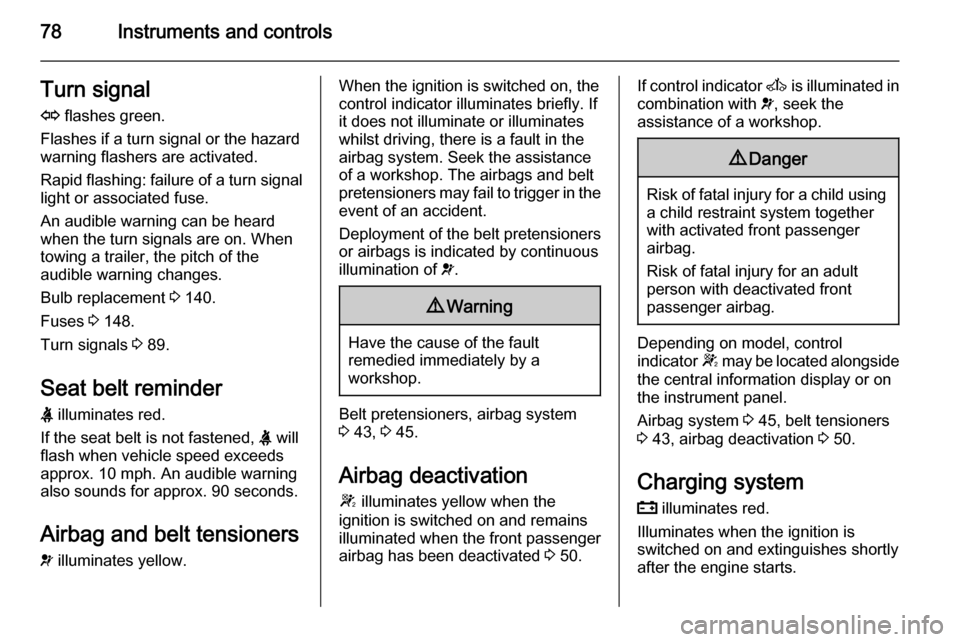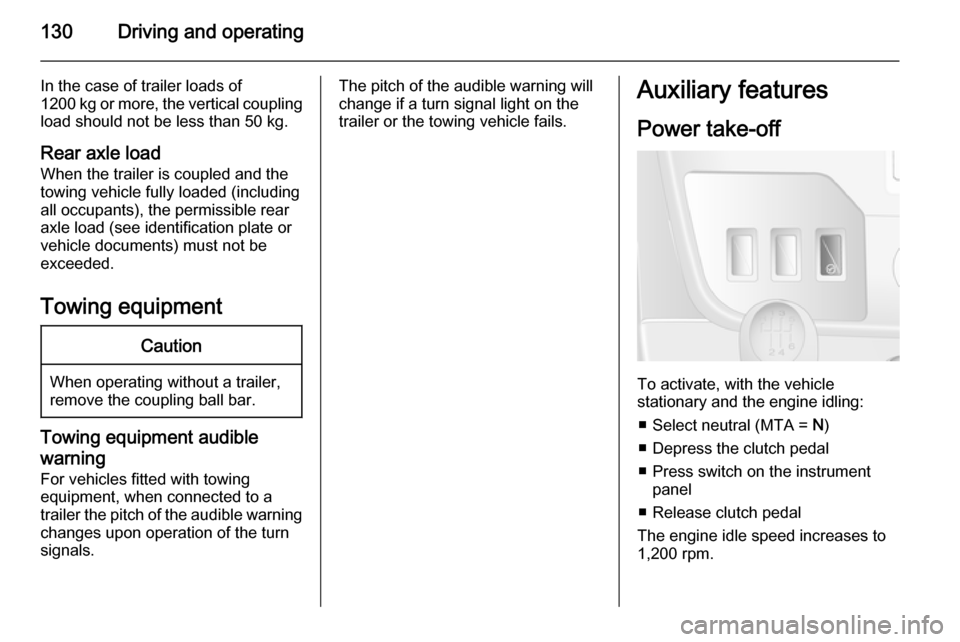2014 VAUXHALL MOVANO_B trailer
[x] Cancel search: trailerPage 80 of 201

78Instruments and controlsTurn signal
O flashes green.
Flashes if a turn signal or the hazard
warning flashers are activated.
Rapid flashing: failure of a turn signal light or associated fuse.
An audible warning can be heard
when the turn signals are on. When
towing a trailer, the pitch of the
audible warning changes.
Bulb replacement 3 140.
Fuses 3 148.
Turn signals 3 89.
Seat belt reminder
X illuminates red.
If the seat belt is not fastened, X will
flash when vehicle speed exceeds
approx. 10 mph. An audible warning
also sounds for approx. 90 seconds.
Airbag and belt tensioners
v illuminates yellow.When the ignition is switched on, the
control indicator illuminates briefly. If
it does not illuminate or illuminates
whilst driving, there is a fault in the
airbag system. Seek the assistance
of a workshop. The airbags and belt
pretensioners may fail to trigger in the event of an accident.
Deployment of the belt pretensioners
or airbags is indicated by continuous
illumination of v.9 Warning
Have the cause of the fault
remedied immediately by a
workshop.
Belt pretensioners, airbag system
3 43, 3 45.
Airbag deactivation
W illuminates yellow when the
ignition is switched on and remains
illuminated when the front passenger
airbag has been deactivated 3 50.
If control indicator A is illuminated in
combination with v, seek the
assistance of a workshop.9 Danger
Risk of fatal injury for a child using
a child restraint system together
with activated front passenger
airbag.
Risk of fatal injury for an adult
person with deactivated front
passenger airbag.
Depending on model, control
indicator W may be located alongside
the central information display or on
the instrument panel.
Airbag system 3 45, belt tensioners
3 43, airbag deactivation 3 50.
Charging system
p illuminates red.
Illuminates when the ignition is
switched on and extinguishes shortly
after the engine starts.
Page 108 of 201

106Driving and operatingDriving and operatingDriving hints............................... 106
Starting and operating ...............106
Engine exhaust .......................... 112
Manual transmission ..................113
Manual transmission automa‐
ted .............................................. 114
Brakes ........................................ 118
Ride control systems .................119
Driver assistance systems .........121
Fuel ............................................ 127
Trailer hitch ................................ 129
Auxiliary features .......................130Driving hints
Control of the vehicleNever coast with engine not
running (except during Autostop)
Many systems will not function in this
situation (e.g. brake servo unit, power steering). Driving in this manner is a
danger to yourself and others. All
systems function during an Autostop,
but there will be a controlled reduction
in power steering assist and vehicle
speed is reduced.
Stop-start system 3 108.
Pedals
To ensure the pedal travel is
uninhibited, there must be no mats in the area of the pedals.
Power steering Never leave the steering wheel on full
lock when the vehicle is stationary as this may damage the power steering
pump.Starting and operating
New vehicle running-in
Do not brake unnecessarily hard for
the first few journeys and after new
disc brake pads have been fitted.
During the first drive, smoke may
occur because of wax and oil
evaporating off the exhaust system.
Park the vehicle in the open for a
while after the first drive and avoid
inhaling the fumes.
During the running-in period fuel and
engine oil consumption may be
higher and the cleaning process of the diesel particle filter may take
place more often. Autostop may be inhibited to allow for charging the
vehicle battery.
Stop-start system 3 108.
Diesel particle filter 3 112.
Page 131 of 201

Driving and operating129Trailer hitch
General information
Only use towing equipment that has
been approved for your vehicle.
Entrust fitting of towing equipment at
a later date to a workshop. It may be
necessary to make changes that
affect the cooling system, heat
shields or other equipment.
Driving characteristics and
towing tips In the case of trailers with brakes,
attach the breakaway stopping cable.
Before attaching a trailer, lubricate
the coupling ball. However, do not do
so if a stabiliser, which acts on the
coupling ball, is being used to reduce snaking movements. For trailers with
low driving stability the use of a
stabiliser is recommended.
A maximum speed of 50 mph must
not be exceeded, even in countries
where higher speeds are permitted.If the trailer starts snaking, drive more
slowly, do not attempt to correct the
steering and brake sharply if
necessary.
When driving downhill, drive in the
same gear as if driving uphill and
drive at a similar speed.
Adjust tyre pressure to the value
specified for full load 3 189.
Trailer towing Trailer loads
The permissible trailer loads are
vehicle-dependent and engine-
dependent maximum values which
must not be exceeded. The actual trailer load is the difference between
the actual gross weight of the trailer
and the actual coupling socket load
with the trailer coupled.
The permissible trailer loads are
specified in the vehicle documents. In general, they are valid for gradients
up to max. 12 %.
The permitted trailer load applies up to the specified incline and up to an
altitude of 1000 metres above sealevel. Since engine power decreases
as altitude increases due to the air
becoming thinner, therefore reducing
climbing ability, the permissible gross
train weight also decreases by 10 %
for every 1000 metres of additional
altitude. The gross train weight does
not have to be reduced when driving
on roads with slight inclines (less than
8 %, e.g. motorways).
The permissible gross train weight
must not be exceeded. This weight is
specified on the identification plate
3 171.
Vertical coupling load
The vertical coupling load is the load
exerted by the trailer on the coupling
ball. It can be varied by changing the
weight distribution when loading the
trailer.
The maximum permissible vertical
coupling load is specified on the
towing equipment identification plate
and in the vehicle documents. Always aim for the maximum load, especially
in the case of heavy trailers. The
vertical coupling load should never
fall below 25 kg.
Page 132 of 201

130Driving and operating
In the case of trailer loads of
1200 kg or more, the vertical coupling load should not be less than 50 kg.
Rear axle load
When the trailer is coupled and the
towing vehicle fully loaded (including all occupants), the permissible rear
axle load (see identification plate or
vehicle documents) must not be
exceeded.
Towing equipmentCaution
When operating without a trailer,
remove the coupling ball bar.
Towing equipment audible
warning For vehicles fitted with towing
equipment, when connected to a
trailer the pitch of the audible warning
changes upon operation of the turn
signals.
The pitch of the audible warning will
change if a turn signal light on the
trailer or the towing vehicle fails.Auxiliary features
Power take-off
To activate, with the vehicle
stationary and the engine idling:
■ Select neutral (MTA = N)
■ Depress the clutch pedal
■ Press switch on the instrument panel
■ Release clutch pedal
The engine idle speed increases to 1,200 rpm.
Page 199 of 201

197
Pollen filter ................................. 104
Power door locks ..........................22
Power outlets ............................... 71
Power side step ............................ 24
Power sliding door ........................24
Power steering fluid ....................136
Power take-off ........................... 130
Power windows ............................ 32
Preheating ................................... 81
Puncture ............................. 154, 157
R Radio Frequency Identification (RFID) ..................................... 192
Radio remote control ...................18
Reading lights .............................. 91
Rear air conditioning system .......99
Rear doors ................................... 26
Rear fog light ............................... 82
Rear fog lights ............................. 90
Rear heating system .................... 97
Rear seats .................................... 41
Rear view camera ...................... 126
Rear windows .............................. 32
Recommended fluids and lubricants ........................ 168, 173
Refuelling ................................... 127 Remote control ............................. 18
Reversing lights ........................... 90
Ride control systems ..................119Roof.............................................. 34
Roof load ...................................... 66
Roof rack ..................................... 66
S Safety belts ................................... 43
Safety net .................................... 65
Seat adjustment ....................... 7, 37
Seat belt ........................................ 8
Seat belt reminder .......................78
Seat belts ..................................... 43
Seat heating ................................. 40
Seat position ................................ 36
Selector lever ............................. 114
Service ............................... 105, 167
Service display ............................ 75
Service information ....................167
Service vehicle soon .................... 79
Side airbag system ......................49
Sidelights ...................................... 87
Side turn signal lights ................145
Sliding door .................................. 24
Spare wheel ............................... 159
Speedometer ............................... 73
Speed regulator ............................ 73
Starting and operating ................106
Starting off ................................... 16
Starting the engine ............107, 114
Steering column controls ..............69
Steering wheel adjustment ......9, 68Steering wheel controls ...............68
Stop engine .................................. 79
Stop-start system.................. 82, 108
Storage ......................................... 60
Storage compartments .................60
Sunglasses storage .....................61
Sun visors .................................... 34
Suspension seat ........................... 37
Symbols ......................................... 4
T
Tachograph ............................ 82, 86
Tachometer ................................. 73
Tail lights ................................... 144
Technical data ............................ 174
Three-point seat belt .................... 44
Tools .......................................... 150
Top-tether fastening eyes ............59
Tow bar....................................... 129
Towing ........................................ 129
Towing another vehicle .............163
Towing a trailer ........................... 129
Towing equipment .....................130
Towing eye ................................. 162
Towing the vehicle .....................162
Traction Control system ............. 119
Trailer coupling ........................... 129
Trailer towing ............................. 129
Transmission ............................... 15
Transmission display ...........75, 114